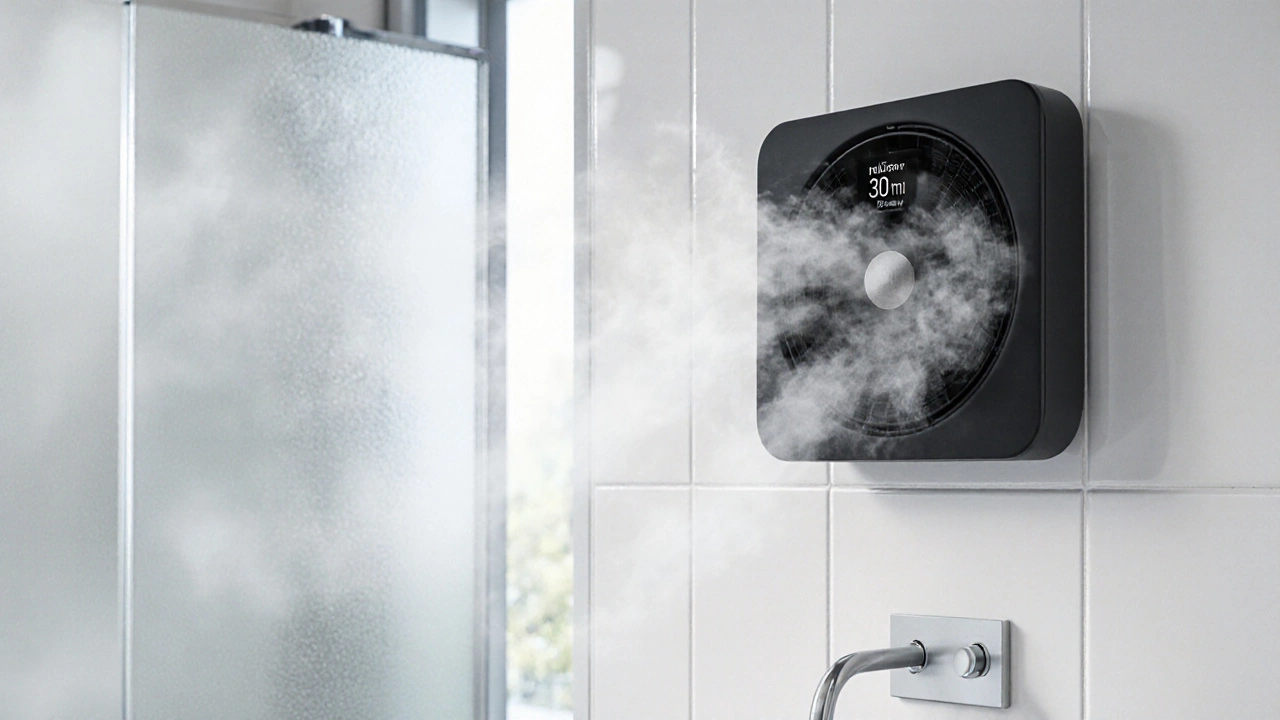Extractor Fan Energy Calculator
Calculate Your Fan's Energy Use
See how much energy and money you're wasting by leaving your extractor fans running all day.
Leaving your extractor fan on all day might seem like a harmless habit-especially if you’re trying to keep moisture out of the bathroom or clear out cooking smells from the kitchen. But is it really safe? Does it waste energy? Could it break down faster? The answer isn’t as simple as yes or no. It depends on how your fan is built, how often you use it, and what you’re trying to achieve.
Why People Leave Extractor Fans On
Most people leave extractor fans running for one of three reasons: to remove steam after a shower, to get rid of cooking odors, or to prevent mold. In humid climates like Wellington, where dampness builds up quickly indoors, running the fan feels like a smart move. But running it for hours-or all day-can cause more problems than it solves.Take a typical bathroom extractor fan. It’s designed to pull moist air out of a small space in 15 to 30 minutes. That’s it. Most models don’t have motors built to run continuously. If you leave it on for 8, 12, or 24 hours, you’re putting unnecessary stress on the motor, bearings, and wiring. Over time, this leads to premature failure. And when it breaks, you’re not just dealing with a noisy fan-you’re risking mold growth because the system isn’t working anymore.
Energy Use: How Much Are You Really Spending?
A standard bathroom extractor fan uses between 15 and 60 watts of power. That doesn’t sound like much. But if you leave it running 24/7, you’re using about 1.44 kWh per day. Over a month, that’s 43.2 kWh. At New Zealand’s average electricity rate of around 30 cents per kWh, you’re paying roughly $13 a month just to run one fan.That’s not a huge amount, but it adds up. If you’ve got fans running in the bathroom, kitchen, and laundry-each on all day-that’s nearly $40 a month wasted. And it’s not just about the bill. Every extra kilowatt used means more carbon emissions. In a country pushing for net-zero emissions by 2050, small habits like this matter.
What Happens When You Run a Fan Too Long?
Extractor fans aren’t industrial-grade ventilation systems. They’re built for intermittent use. Here’s what happens when you push them beyond their design:- Motor overheating: The motor isn’t designed to cool itself over long periods. Continuous operation causes heat buildup, which degrades insulation on the windings.
- Bearing wear: The bearings inside the fan motor wear out faster when spinning nonstop. You’ll hear a grinding or whining noise before it fails completely.
- Dust and grease buildup: If the fan pulls in cooking grease or bathroom humidity without proper filtration, residue sticks to the blades and housing. Over time, this clogs airflow and forces the motor to work harder.
- Wiring damage: Constant vibration and heat can loosen connections inside the wall or ceiling box. This is a fire risk in older homes with outdated wiring.
One repair technician in Christchurch told me he sees at least two extractor fan failures per week during winter months. All of them were from people leaving fans on overnight or all day to ‘dry out’ the room. The fans weren’t broken because of water-they broke because of heat and wear.

When Is It Actually OK to Leave the Fan On?
There are a few exceptions. If your fan has a built-in timer or humidity sensor, then yes-it’s designed to run longer. Modern extractor fans from brands like Broan, a U.S.-based manufacturer known for residential ventilation systems that include timers and humidity sensors or Extracta, an Australian brand popular in New Zealand for high-efficiency bathroom fans with auto-shutoff features can run for 20 to 60 minutes after you leave the room. These are safe to leave on because they turn off automatically.Also, if you’re doing heavy-duty cooking-like frying fish or roasting meat-running the kitchen extractor fan for 30 to 45 minutes is fine. Just make sure it’s vented to the outside, not just recirculating air through a charcoal filter. Recirculating fans don’t remove moisture; they just trap grease. And if your fan is vented to the attic or wall cavity instead of outside, it’s doing more harm than good.
Best Practices for Running Your Extractor Fan
Here’s what actually works, based on real-world testing and repair data from across New Zealand:- Run it during and 15-30 minutes after use. That’s enough to clear steam and odors without overworking the motor.
- Install a timer switch. For under $50, you can replace a regular switch with a 15- or 30-minute timer. It’s the cheapest upgrade you’ll ever make.
- Use a humidity sensor fan. These turn on automatically when moisture rises and shut off when the air is dry. No guessing. No wasted energy.
- Clean the fan every 6 months. Remove the cover, wipe the blades, and vacuum the housing. Grease and dust kill fans faster than running them too long.
- Check your vent duct. Make sure it’s not kinked, crushed, or blocked. A blocked duct makes the fan work harder and reduces efficiency by up to 60%.
Signs Your Extractor Fan Is About to Fail
If you notice any of these, don’t wait for it to stop working completely:- It makes a loud buzzing or grinding noise
- It doesn’t pull air as strongly as it used to
- You see dust or grease buildup around the edges
- The fan turns on but the blades don’t spin
- It smells like burning plastic or overheated metal
These aren’t signs you need to clean the fan-they’re signs you need to replace it. Trying to fix a worn-out motor usually costs more than buying a new unit. And if you’re in an older home, upgrading to a modern, energy-efficient model can cut your ventilation costs in half.
What to Look for When Replacing an Extractor Fan
Not all extractor fans are created equal. Here’s what to check before you buy:| Type | Power Use (Watts) | Max Run Time | Auto Shut-Off? | Best For |
|---|---|---|---|---|
| Basic Fan (No Timer) | 20-40 | 30 minutes | No | Low-budget bathrooms |
| Timer Fan | 25-50 | 15-60 minutes | Yes | Most homes |
| Humidity Sensor Fan | 30-60 | Variable | Yes | High-humidity areas, Wellington homes |
| Quiet Fan (Under 20 dB) | 15-40 | 60 minutes | Yes | Near bedrooms or living areas |
| Recirculating Fan | 10-30 | Not recommended | No | Only if no external vent exists |
For most New Zealand homes, a humidity sensor fan with a 60-minute auto-shutoff is the best balance of performance, cost, and reliability. Brands like Vent-Axia, a UK-based brand with models widely available in New Zealand that meet local moisture control standards and Broan-NuTone, a trusted name in residential ventilation with certified energy-efficient models offer units that are quiet, effective, and built to last.
Final Answer: Is It OK to Leave an Extractor Fan On?
No, it’s not OK to leave a standard extractor fan running all day. It wastes energy, shortens the fan’s life, and increases your risk of breakdowns. If you need continuous ventilation-like in a high-humidity bathroom or a kitchen with heavy cooking-invest in a fan with a timer or humidity sensor. These are designed to run longer safely.Running a fan for 30 minutes after a shower or cooking session is enough. Anything longer is unnecessary-and potentially damaging. Your wallet, your energy bill, and your fan will thank you.
Can leaving an extractor fan on cause a fire?
Yes, in rare cases. If the fan is old, dusty, or has frayed wiring, continuous operation can cause the motor to overheat. This is especially risky in homes with outdated electrical systems. While fires from extractor fans are uncommon, they do happen-usually because the fan was left running for days without maintenance.
Should I leave the extractor fan on overnight?
Only if it’s a modern fan with a humidity sensor or timer. A basic fan left on all night will wear out quickly and waste electricity. If you’re worried about mold, open a window slightly instead, or install a smart fan that turns on only when moisture levels rise.
How long should I run my extractor fan after a shower?
Run it for 15 to 30 minutes after you finish showering. That’s enough time to remove steam and prevent condensation on walls and windows. Most people turn it off too soon, which lets moisture linger and cause mold. Running it longer than 30 minutes offers no extra benefit.
Do extractor fans use a lot of electricity?
Individually, no-a typical fan uses less than a lightbulb. But if you have multiple fans running 24/7, the cost adds up. One fan on all day costs about $13 a month. Three fans cost nearly $40. That’s money you’re throwing away.
What’s better: a timer fan or a humidity sensor fan?
A humidity sensor fan is better for most homes. It turns on automatically when moisture is high and shuts off when the air is dry. A timer fan runs for a fixed time, even if the room is already dry. In Wellington’s damp climate, the sensor version saves energy and prevents mold more effectively.
Can I replace my extractor fan myself?
Yes, if you’re comfortable with basic wiring. Most modern fans plug into a standard junction box and mount with screws. Turn off the power at the circuit breaker first. If your fan is wired directly into the wall without a plug, or if you’re unsure about the wiring, hire a licensed electrician. Safety comes first.
Next Steps: What to Do Today
If you’re not sure whether your fan is safe to leave on, do this now:- Check the label on your fan. Does it say “continuous run” or “24/7 rated”? If not, assume it’s not designed for it.
- Turn it on and listen. Does it sound strained? Is there a buzzing noise? That’s a sign it’s worn out.
- Look at the vent duct outside. Is it clear? Is air actually coming out? If not, your fan is working harder than it should.
- Set a timer for 30 minutes after your next shower. See how the air feels afterward. You’ll probably find 30 minutes is enough.
- If you’re still unsure, replace your fan with a humidity sensor model. It’s the easiest way to stop guessing and start saving.
Extractor fans are meant to help-not to be left running like a background appliance. Treat them like your dishwasher: turn them on when you need them, turn them off when you don’t. Your home-and your wallet-will be better for it.









